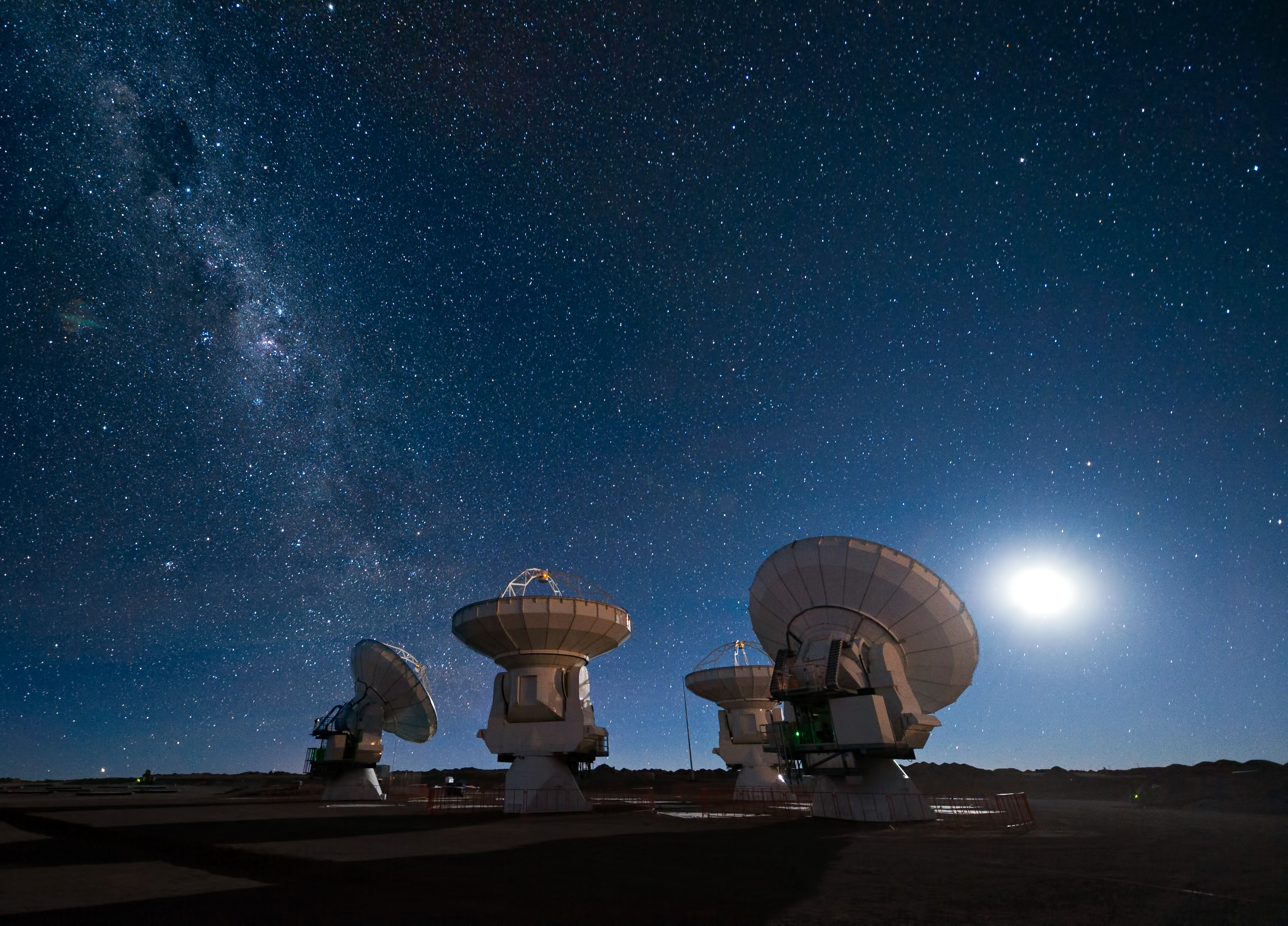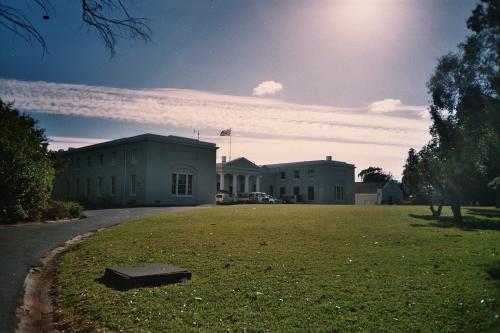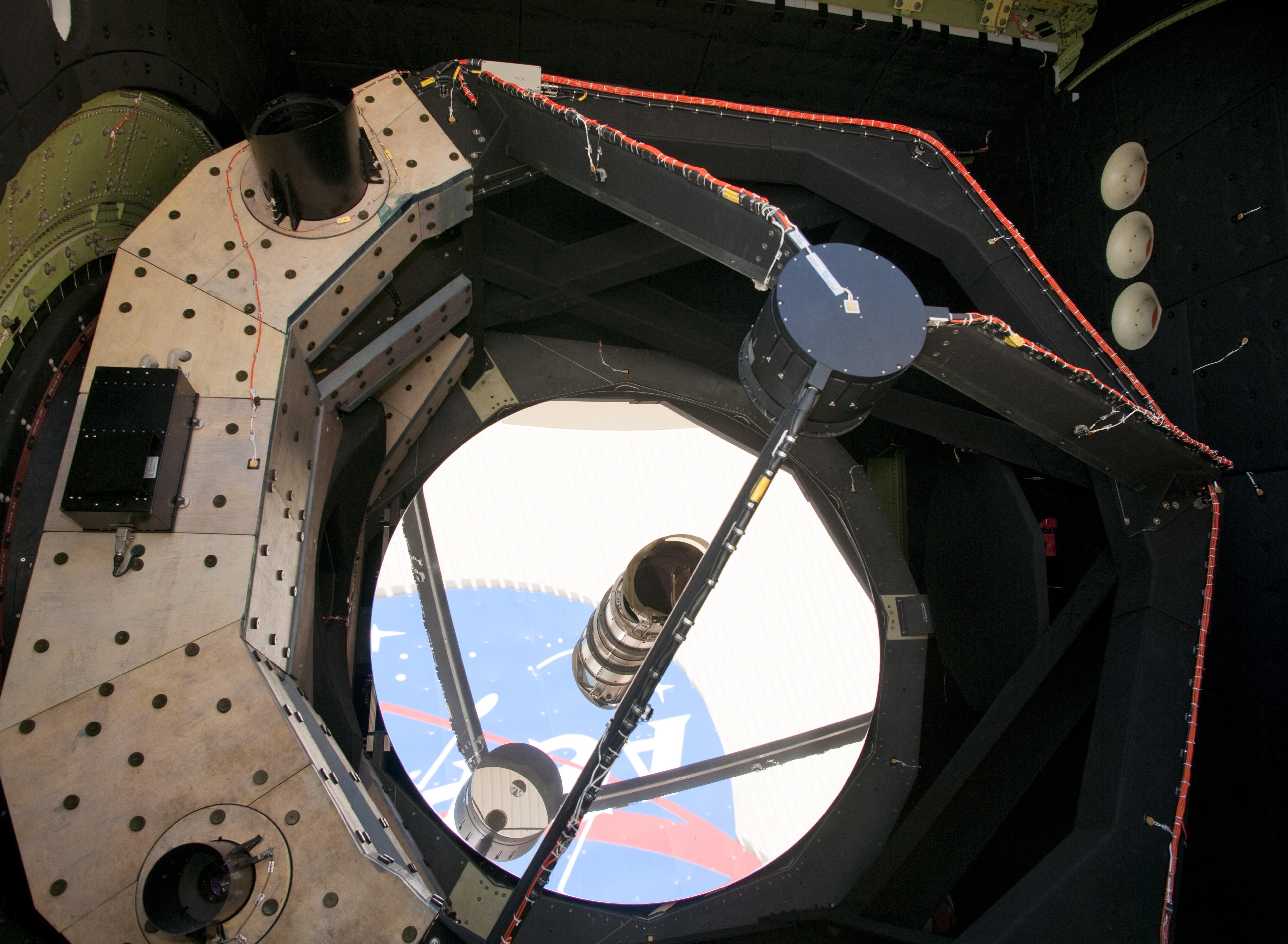|
KAT-7
KAT-7 is a radio telescope situated in the Meerkat National Park, in the Northern Cape of South Africa. Part of the Karoo Array Telescope project, it is the precursor engineering test bed to the larger MeerKAT telescope, but it has become a science instrument in its own right. The construction was completed in 2011 and commissioned in 2012. It also served as a technology demonstrator for South Africa's bid to host the Square Kilometre Array. KAT-7 is the first Radio telescope to be built with a composite reflector and uses a stirling pump for 75 K cryogenic cooling. The telescope was built to test various system for the MeerKAT array, from the ROACH correlators designed and manufactured in Cape Town, now used by various telescopes internationally, to composite construction techniques. Technical specifications KAT-7 consist of 7 dishes of 12 metres in diameter, each a prime focus reflecting telescope. Performance In April 2010 four of the seven dishes were linked toge ... [...More Info...] [...Related Items...] OR: [Wikipedia] [Google] [Baidu] |
MeerKAT
MeerKAT, originally the Karoo Array Telescope, is a radio telescope consisting of 64 antennas in the Meerkat National Park, in the Northern Cape of South Africa. In 2003, South Africa submitted an expression of interest to host the Square Kilometre Array (SKA) Radio Telescope in Africa, and the locally designed and built MeerKAT was incorporated into the first phase of the SKA. MeerKAT was launched in 2018. Along with the Hydrogen Epoch of Reionization Array (HERA), also in South Africa, and two radio telescopes in Western Australia, the Australian SKA Pathfinder (ASKAP) and the Murchison Widefield Array (MWA), the MeerKAT is one of four precursors to the final SKA. History MeerKAT is a precursor for the SKA-mid array, as are the Hydrogen Epoch of Reionization Array (HERA), the Australian SKA Pathfinder (ASKAP) and the Murchison Widefield Array (MWA). Description It is located on the SKA site in the Karoo, and is a pathfinder for SKA-mid technologies and science. It was design ... [...More Info...] [...Related Items...] OR: [Wikipedia] [Google] [Baidu] |
Hartebeesthoek Radio Astronomy Observatory
The Hartebeesthoek Radio Astronomy Observatory (HartRAO) is a radio astronomy observatory, located in a natural bowl of hills at Hartebeesthoek just south of the Magaliesberg mountain range, Gauteng, South Africa, about 50 km west of Johannesburg. It is a National Research Facility run by South Africa's National Research Foundation. HartRAO was the only major radio astronomy observatory in Africa until the construction of the KAT-7 test bed for the future MeerKAT array. History The observatory was originally named Deep Space Station 51 (DSS51) and was built in 1961 by the National Aeronautics and Space Administration (NASA). In this role the station assisted in tracking many unmanned United States space missions, including the Ranger, Surveyor and Lunar Orbiter spacecraft (which landed on the Moon or mapped it from orbit), the Mariner missions (which explored the planets Venus and Mars) and the Pioneer missions (which measured the Sun's winds). The first Mars surface imag ... [...More Info...] [...Related Items...] OR: [Wikipedia] [Google] [Baidu] |
Square Kilometre Array
The Square Kilometre Array (SKA) is an intergovernmental international radio telescope project being built in Australia (low-frequency) and South Africa (mid-frequency). The combining infrastructure, the Square Kilometre Array Observatory (SKAO), and headquarters, are located at the Jodrell Bank Observatory in the United Kingdom. The SKA cores are being built in the southern hemisphere, where the view of the Milky Way galaxy is the best and radio interference at its least. Conceived in the 1990s, and further developed and designed by the late-2010s, when completed a total collecting area of approximately one square kilometre. It will operate over a wide range of frequencies and its size will make it 50 times more sensitive than any other radio instrument. If built as planned, it should be able to survey the sky more than ten thousand times faster than before. With receiving stations extending out to a distance of at least from a concentrated central core, it will exploit r ... [...More Info...] [...Related Items...] OR: [Wikipedia] [Google] [Baidu] |
List Of Radio Telescopes
This is a list of radio telescopes – over one hundred – that are or have been used for radio astronomy. The list includes both single dishes and interferometric arrays. The list is sorted by region, then by name; unnamed telescopes are in reverse size order at the end of the list. The first radio telescope was invented in 1932, when Karl Jansky at Bell Telephone Laboratories observed radiation coming from the Milky Way. Africa Antarctica Asia Australia Europe North America South America Arctic Ocean Atlantic Ocean Indian Ocean Pacific Ocean Space-based Under construction or planned construction Proposed telescopes Gallery of big dishes File:FastTelescope*8sep2015.jpg, alt=Five hundred meter Aperture Spherical Telescope under construction, The 500 meter Five hundred meter Aperture Spherical Telescope (FAST), under construction, China (2016) File:GBT.png, alt=Green Bank Telescope, The 100 meter Green Bank Telescope, ... [...More Info...] [...Related Items...] OR: [Wikipedia] [Google] [Baidu] |
Radio Telescope
A radio telescope is a specialized antenna and radio receiver used to detect radio waves from astronomical radio sources in the sky. Radio telescopes are the main observing instrument used in radio astronomy, which studies the radio frequency portion of the electromagnetic spectrum emitted by astronomical objects, just as optical telescopes are the main observing instrument used in traditional optical astronomy which studies the light wave portion of the spectrum coming from astronomical objects. Unlike optical telescopes, radio telescopes can be used in the daytime as well as at night. Since astronomical radio sources such as planets, stars, nebulas and galaxies are very far away, the radio waves coming from them are extremely weak, so radio telescopes require very large antennas to collect enough radio energy to study them, and extremely sensitive receiving equipment. Radio telescopes are typically large parabolic ("dish") antennas similar to those employed in tracking an ... [...More Info...] [...Related Items...] OR: [Wikipedia] [Google] [Baidu] |
VLBI
Very-long-baseline interferometry (VLBI) is a type of astronomical interferometry used in radio astronomy. In VLBI a signal from an astronomical radio source, such as a quasar, is collected at multiple radio telescopes on Earth or in space. The distance between the radio telescopes is then calculated using the time difference between the arrivals of the radio signal at different telescopes. This allows observations of an object that are made simultaneously by many radio telescopes to be combined, emulating a telescope with a size equal to the maximum separation between the telescopes. Data received at each antenna in the array include arrival times from a local atomic clock, such as a hydrogen maser. At a later time, the data are correlated with data from other antennas that recorded the same radio signal, to produce the resulting image. The resolution achievable using interferometry is proportional to the observing frequency. The VLBI technique enables the distance between t ... [...More Info...] [...Related Items...] OR: [Wikipedia] [Google] [Baidu] |
Buildings And Structures In The Northern Cape
A building, or edifice, is an enclosed structure with a roof and walls standing more or less permanently in one place, such as a house or factory (although there's also portable buildings). Buildings come in a variety of sizes, shapes, and functions, and have been adapted throughout history for a wide number of factors, from building materials available, to weather conditions, land prices, ground conditions, specific uses, monument, prestige, and aesthetic reasons. To better understand the term ''building'' compare the list of nonbuilding structures. Buildings serve several societal needs – primarily as shelter from weather, security, living space, privacy, to store belongings, and to comfortably live and work. A building as a shelter represents a physical division of the :Human habitats, human habitat (a place of comfort and safety) and the ''outside'' (a place that at times may be harsh and harmful). Ever since the first cave paintings, buildings have also become objects or ... [...More Info...] [...Related Items...] OR: [Wikipedia] [Google] [Baidu] |
Astronomical Observatories In South Africa
Astronomy () is a natural science that studies celestial objects and phenomena. It uses mathematics, physics, and chemistry in order to explain their origin and evolution. Objects of interest include planets, moons, stars, nebulae, galaxies, and comets. Relevant phenomena include supernova explosions, gamma ray bursts, quasars, blazars, pulsars, and cosmic microwave background radiation. More generally, astronomy studies everything that originates beyond Earth's atmosphere. Cosmology is a branch of astronomy that studies the universe as a whole. Astronomy is one of the oldest natural sciences. The early civilizations in recorded history made methodical observations of the night sky. These include the Babylonians, Greeks, Indians, Egyptians, Chinese, Maya, and many ancient indigenous peoples of the Americas. In the past, astronomy included disciplines as diverse as astrometry, celestial navigation, observational astronomy, and the making of calendars. Nowadays, professional a ... [...More Info...] [...Related Items...] OR: [Wikipedia] [Google] [Baidu] |
Precision Array For Probing The Epoch Of Reionization
The Donald C. Backer Precision Array for Probing the Epoch of Reionization (PAPER) is a radio interferometer funded by the National Science Foundation to detect 21 cm hydrogen (HI) fluctuations occurring when the first galaxies ionized intergalactic gas at around 500 Million years after the Big Bang. PAPER is a focused experiment aimed toward making the first statistical detection of the 21 cm reionization signal. Given the stringent dynamic range requirements for detecting reionization in the face of foregrounds that are five orders of magnitude brighter, the PAPER project is taking a carefully staged engineering approach, optimizing each component in the array to mitigate, at the outset, any potentially debilitating problems in subsequent data calibration and analysis. This staged approach addresses the observational challenges that arise from very-wide-field, high-dynamic-range imaging over wide bandwidths in the presence of transient terrestrial interference. PAPE ... [...More Info...] [...Related Items...] OR: [Wikipedia] [Google] [Baidu] |
South African Astronomical Observatory
South African Astronomical Observatory (SAAO) is the national centre for optical and infrared astronomy in South Africa. It was established in 1972. The observatory is run by the National Research Foundation of South Africa. The facility's function is to conduct research in astronomy and astrophysics. The primary telescopes are located in Sutherland, which is from Observatory, Cape Town, where the headquarters is located. The SAAO has links worldwide for scientific and technological collaboration. Instrumental contributions from the South African Astronomical Observatory include the development of a spherical aberration corrector and the Southern African Large Telescope (SALT). The Noon Gun on Cape Town's Signal Hill is fired remotely by a time signal from the Observatory. History The history of the SAAO began when the Royal Observatory at the Cape of Good Hope was founded in 1820, the first scientific institution in Africa. Construction of the main buildings was complet ... [...More Info...] [...Related Items...] OR: [Wikipedia] [Google] [Baidu] |
Australian Square Kilometre Array Pathfinder
The Australian Square Kilometre Array Pathfinder (ASKAP) is a radio telescope array located at Murchison Radio-astronomy Observatory (MRO) in the Mid West region of Western Australia. The facility began as a technology demonstrator for the international Square Kilometre Array (SKA), an internationally-planned radio telescope which will be larger and more sensitive. The ASKAP site has been selected as one of the SKA's two central locations. It is operated by the Commonwealth Scientific and Industrial Research Organisation (CSIRO) and forms part of the Australia Telescope National Facility. Construction commenced in late 2009 and first light was in October 2012. ASKAP consists of 36 identical parabolic antennas, each in diameter, working together as a single astronomical interferometer with a total collecting area of approximately . Each antenna is equipped with a phased-array feed (PAF), significantly increasing the field of view. This design provides both fast survey speed ... [...More Info...] [...Related Items...] OR: [Wikipedia] [Google] [Baidu] |
Reflecting Telescope
A reflecting telescope (also called a reflector) is a telescope that uses a single or a combination of curved mirrors that reflect light and form an image. The reflecting telescope was invented in the 17th century by Isaac Newton as an alternative to the refracting telescope which, at that time, was a design that suffered from severe chromatic aberration. Although reflecting telescopes produce other types of optical aberrations, it is a design that allows for very large diameter objectives. Almost all of the major telescopes used in astronomy research are reflectors. Many variant forms are in use and some employ extra optical elements to improve image quality or place the image in a mechanically advantageous position. Since reflecting telescopes use mirrors, the design is sometimes referred to as a catoptrics, catoptric telescope. From the time of Newton to the 1800s, the mirror itself was made of metal usually speculum metal. This type included Newton's first designs and eve ... [...More Info...] [...Related Items...] OR: [Wikipedia] [Google] [Baidu] |

.jpg)







